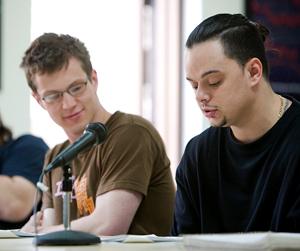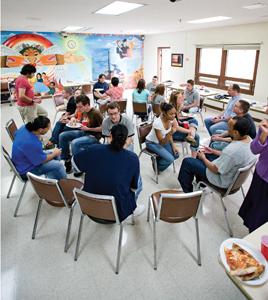Two and a Half Hours a Week
By Elizabeth Chiles Shelburne '01
 |
Greg
was flipping through pages of class readings. He was looking for a
specific example to support his point about changing gender roles among
Cambodian refugees fleeing the Pol Pot regime. He flipped one page,
then another and another.
“I can’t find it right now,” he told
a classmate. “I don’t have a highlighter.... I’d like to have one, a
couple different highlighters, so I could...” His voice trailed off as
he mimed the act of marking up the passages by topic.
Greg had
pored over the readings; every page bore the penciled-in marginalia of
a determined student. But he isn’t just any Amherst student, and the
giveaway was that he had only a pencil at his disposal. The Hampshire
Jail and House of Corrections has strict rules, and as long as Greg was
imprisoned there, he had to follow them, even during the two and a half
hours each Wednesday that he spent taking Regulating Citizenship, an
Amherst political science course taught by Kristin Bumiller, a
professor of political science and women’s and gender studies.
Most
of the cinderblock visiting room at the jail is painted an
institutional cream color that might well be called “bleak” in the
Benjamin Moore catalog. One wall, though, showcases a colorful mural
with a number of scenes that are meant to be uplifting: a man in a
graduation cap and gown, family crowded around in pride; a
multicultural group of men and women holding hands around the earth;
what looks like a camel wearing an orange robe, a city of skyscrapers
on his back, his angel wings poised for flight. Crooked posters of the
beach at sunset hang on the other walls, extolling such gems as “Watch
your character, it becomes your destiny.” This is made-to-order
inspiration, with none of the real thing. Posters and paint cannot hide
the red line taped in front of the door that leads out of the jail, the
red line that no resident of the facility can put even a toe across.
Luckily for the students in Bumiller’s class, inspiration was dependent
not upon the decorations but upon the conversation occurring within the
room.
For 13 weeks last semester, 10 students serving terms in the Hampshire Jail and 11 Amherst students met in this room for Bumiller’s course. They read and discussed Foucault, Locke, Thoreau, Arendt and Kafka, among others, as they examined what citizenship means and how the state can take it away.
Is it possible
for an educational system to be conducted by a national state and yet
the full social ends of the educative process not be restricted,
constrained and corrupted?
—John Dewey, Democracy and Education, from the course readings
 |
Today,
there are few educational opportunities in U.S. prisons, and the ones
that do exist focus mostly on secondary education. Programs for college
credit are scarce, despite research by the U.S. Department of Justice
showing that convicts with some college education are less likely to
end up in jail again. In 1994, Congress ruled that prisoners are
ineligible for Pell grants for higher education, a decision that proved
disastrous for college-level education in prisons. In 1983, 41 state
prison systems offered post-secondary education courses, enrolling
nearly 5 percent of the total prison population, according to a 2005
Ford Foundation report. By 1997, only 21 states offered such programs,
and less than 2 percent of the prison population was enrolled. In 2005,
enrollment was back near 5 percent, but the educational focus had
shifted: two-thirds of the offerings were vocational programs as
opposed to courses that count towards a bachelor’s or graduate degree.
One
of the most important of these programs, and the one that got Bumiller
into the Hampshire facility, is the Inside-Out Prison Exchange Program,
which is run by Lori Pompa, a professor at Temple University. In 1997,
Pompa took one of her Temple classes to a Pennsylvania state prison.
When the students talked with several prisoners, a man serving a life
sentence suggested that Pompa ought to turn these conversations into a
semester-long class. Pompa agreed, and Inside-Out was born. For seven
years, the program existed only at Temple, but Pompa realized that
others might be interested in a similar partnership. In 2004, she began
to offer training for professors to take the program back to their own
colleges and universities. Today, the program has trained 130
professors from 33 states and has enrolled more than 5,000 students.
 |
When
Bumiller first heard about Inside-Out, she was intrigued. She had long
wanted to teach inside a prison: much of her research has to do with
discrimination, power and social justice, and a prison seemed a natural
place to examine how all those social influences come together. Pompa’s
program held special appeal. “I think what drew me to this was that the
inside students and the outside students learn as equals,” says
Bumiller. “That’s what is so exciting about this: having groups of
people that interact with each other in ways that they wouldn’t without
this program.”
Last spring was Bumiller’s third time teaching
the course. She began the semester with the question “What is a
citizen?,” and went on to ask students to consider how we theoretically
imagine a citizen; how democratic societies exclude people from the
rights of citizenship; and what impact poverty, consumerism, education
and war—and imprisonment—have on a society’s definition of itself.
Bumiller wants her students to understand how a democratic society
decides who belongs and who does not. “I’m deliberately creating a
class that is focusing back on prisons in the United States,” she says,
“by getting people to imagine and learn more about other contexts where
people are living in highly restrictive conditions.”
The jail
itself can function almost as a text. Once, Bumiller remembers, she led
a discussion on the bureaucratic authority behind a uniform and how the
uniform itself becomes a symbol of power. As she spoke, a prison guard,
dressed in uniform, came into the room and stood behind her to take the
first of the afternoon’s two head counts. The class laughed. “I thought
it was one of those perfect learning moments,” Bumiller says. “It’s one
of those things that create clarity by concrete example. Sometimes, the
situation or the scene itself becomes an opportunity to learn something
about how power operates, without putting the inside students on the
spot and having them tell their story.”
 Professor Kristin Bumiller and students on the last day of the semester. |
Bumiller’s emotional
investment in the course and the students is apparent. That commitment
comes partly from her belief that most of her students shouldn’t be
incarcerated in the first place. One in 100 Americans is currently in
jail, according to the Pew Center on the States, and this fact strikes
Bumiller as evidence of American society’s failure to provide for its
citizens equally. If it were up to her, only those who pose a violent
threat would be in prison. The rest would benefit from social support
systems such as job training and job provision, education and mental
health and addiction services. “They need to have employment, they need
to have social connections, and they need to have mental and physical
health,” Bumiller says. “That’s my ultimate goal: not just ‘get
everyone out of prison’ but ‘create a system that is going to encourage
people’s success in society.’”
But she is not in charge of that
system. Her response, then, is to provide access to the best education
she can within the limits of the prison system. For the traditional
Amherst students, she is unabashedly political in her goals. “I want
them to leave with a sense of the real tragedy of the incarceration
rate in the United States,” she says. The course costs the college
about $5,000 per semester, an amount that covers course packets,
transportation for the outside students and entertainment, such as
pizza on the last day of class. Amherst’s Office of the Dean of the
Faculty paid the first two years; last year, the college’s Center for
Community Engagement footed the bill.
Students have to follow a
number of special rules. A dress code, much of it set by the Hampshire
Jail, is laid out in a contract that the entire class must sign. The
students cannot wear clothing that resembles staff uniforms or prison
clothes; they cannot wear sleeveless shirts, spaghetti straps or
anything else “that reveals the skin inappropriately”; they cannot wear
jewelry, underwire bras “or other items sensitive to metal detectors.”
Also forbidden are hooded sweatshirts, tank tops, white T-shirts,
bandanas, hair ties, colored shoelaces, baseball caps, coats and
open-toed shoes. Bumiller recalls with a laugh that on the first day
she taught in the facility, an Amherst student showed up for the van in
a Che Guevara T-shirt. She had to send him home to change. “Amherst is
okay—but not Che Guevara,” she said.
 |
The rules go well beyond a
dress code. In class, the traditional Amherst students are called
“outside students,” the others “inside students.” Bumiller wants them
to see one another as equals. According to the contract, outside
students are not in the class “to study the inside students, to ‘help’
the inside students, to find out why the inside students are
incarcerated, or for the inside group of students or outside group to
‘teach’ the other group.”
Students know each other by first name only. (To maintain that sense of privacy, Bumiller asked Amherst magazine to use only their first names.) Students are not allowed to
exchange contact information. After the end of the semester, they can
never communicate again. The regulation is in place as a security
measure. “I certainly never felt any kind of danger, threat or
trepidation about any of the students in the course,” says Martha
Saxton, an associate professor of history and women’s and gender
studies who, after learning about Regulating Citizenship, taught a
history course at the jail last year. “On the other hand, since all
systems are imperfect, it’s possible you could get someone in the
course who isn’t completely reliable and who might, when [the course is
over], do something foolish.”
Of course, for the students to
even have weekly access to one another is far from a given. Not every
jail is willing to have a professor come in and teach about civil
disobedience, as Bumiller does every year. The Hampshire Jail, which is
roughly 10 miles southwest of the Amherst campus, has, for some of its
prisoners, a focus on rehabilitation and education, with classes on
everything from Spanish to GED preparation. There is a classroom,
called “the school,” in the main building that has computers (without
Internet access), books and movies. Several inside students describe
the Hampshire Jail as “a jail, but not really” because of the focus on
rehabilitation and education. Robert, one of the inside students,
speaks of Sheriff Robert Garvey as someone who genuinely believes in
“helping you address the issues that need to be addressed, making sure
that when you are released, you can be a part of society, living in it
rather than surviving it.” Robert adds, “He doesn’t want us treated
like inmates. He wants us treated like people. When you have a sheriff
that will give you a two-liter of soda and pizza for the jail passing
inspection, that says a lot about a facility.”
The perception is so strong that a popular name for the jail is “Camp Hamp.” Still, when the bulletproof-glass doors clank shut in “the trap,” a holding pen near the facility’s entrance, where only one door can open at any time and only with the approval of an unseen guard in a booth, there is no denying that this is a place that functions upon the denial of freedoms.
I am cognizant of the interrelatedness of
all communities and states. I cannot sit idly by in Atlanta and not be
concerned about what happens in Birmingham. Injustice anywhere is a
threat to justice everywhere. We are caught in an inescapable network
of mutuality, tied in a single garment of destiny. Whatever affects one
directly affects all indirectly.
—Martin Luther King Jr., “Letter from Birmingham Jail,” from the course readings
 |
The
inside and outside students last semester studied the same readings,
dressed in similar clothes and were, in most cases, about the same age,
but it was hard not to hear echoes of their vastly different lives.
Once they began talking, it was easier to distinguish between the two
groups in the room. It was not an intelligence difference—the inside
students brought as much intelligence and arguably more passion to the
course. It was more the way each group had of speaking.
The
Amherst students tended to pad their comments with academic jargon,
dropping in words such as “acculturation” and “assimilation.” The
inside students’ comments came from a less lofty place, and perhaps a
less showy place, but they were just as insightful. In a small-group
conversation on how Cambodians received refugee status after fleeing
the Pol Pot regime, I heard the following exchange:
Marcella: And then also there was this whole movement to not allow any communists in, that the biggest goal was to screen out all communists, so any sort of little implication that they may have had some sort of communist leanings would automatically disqualify them. But because there [were] so many people, [the decision about communist leanings] was based on hearsay and people just talking bad about other people—
Greg: Or somebody else trying to get you to not come....
Marcella: ...Based on these totally arbitrary facts—
Greg: Throwing you under the bus gives me a better chance to get in than you.
In 15 words, Greg had just summed up the point of the questions that Bumiller had raised during the class session.
Bumiller
acknowledges that the inside and outside students leave class having
learned different things. For the inside students, she says, it’s about
opening a door. She aims to give them the chance to talk about their
points of view with people who want to listen. “They are getting a
sense that they are confident in their own abilities to learn,” she
says, “and that they can take full advantage of the situation, just
like any Amherst student.”
Some of the inside students
described the class as an escape. “It’s been really great to have you
guys come here,” said Geremie, an inside student, at the last session.
“After our second class, I was really upset it was over, like, ‘Wow, we
have to go back to jail now.’ Our time here was really like we weren’t
even in jail. So thanks, everyone, for embracing us like we weren’t
inmates.”
 |
For the purposes of Bumiller’s class, they were not
inmates. The inside students get Amherst credit for the course, meaning
that if they go on to college, they will be a few credits ahead.
Bumiller describes herself as a tough grader. She won’t publicly
discuss her grading for the course, except to say that, so far,
everyone has passed. At least one of Bumiller’s students has written to
her to say he’s gone on to a university. (The national Inside-Out
Program does not keep official numbers on what happens to its students
after release from prison, but Pompa, the founder, says the program has
transformed many lives.)
The Hampshire Jail selects eligible
students from residents of a unit in which men live in dorm-like rooms
and spend the bulk of their days in various classes and programs.
Bumiller then interviews each potential student individually. She is
interested, she says, in students for whom the course could be a
springboard to community college or beyond. “I saw this as an
opportunity,” says Robert, one of the inside students. Tony Jack ’07,
who took Regulating Citizenship his senior year, saw such commitment in
his fellow students. “I wouldn’t be where I am today if I hadn’t gone
to Head Start,” Jack says, referring to the early education program for
at-risk children. “This could be their head start.”
Every
outside student I spoke with used the word “experience” when asked why
he or she had taken the course. They wanted to experience a jail in so
far as they could. (One student admitted that she really had no idea
what the topic of “regulating citizenship” would be about.) “If you
haven’t committed a crime,” said an outside student named Chris, who’s
in the Class of ’10, “if the state hasn’t stepped in and started to
change your life yet, it’s easy to not even think about the ways that
the state can come in and change lives.”
Robert wanted the
outside students to see people like him in a new light. “I just hope
that they realize,” he says, “that even though we’re here, we’re still
citizens. Eventually we’re going to be part of society again, so don’t
cast us off. Even though we’ve made mistakes, that doesn’t mean we
can’t change, that we can’t be good people.”
Beyond making them
think in new ways, the class also made the outside students behave in
new ways. “I think Amherst students regularly go to class without doing
the reading,” Bumiller says. “If they come to this class without doing
the reading, and they’re sitting next to an inside student who has read
it three times, has markings all through it, has five pages of notes, I
think they feel pretty embarrassed.” For an Amherst ’08 named Marina,
doing hours of homework was more about a sense of responsibility she
felt to the inside students. “We can’t be disrespectful and not put in
the effort, because we’re part of this class and we’re making the
experience for these people. We knew that for them it was a privilege.”
Totalitarianism is never content to rule by external
means, namely, through the state and a machinery of violence; thanks to
its peculiar ideology and the role assigned to it in this apparatus of
coercion, totalitarianism has discovered a means of dominating and
terrorizing human beings from within.
—Hannah Arendt, Totalitarianism, from the course readings
The
second-to-last class was about prison abuses. “Jails are predicated on
violence,” argued guest speaker Phil Scraton, a penal abolitionist from
Northern Ireland. It was as if Scraton had turned on a faucet. Stories
came pouring out; stories that were worse than the outside students
could have imagined, stories that the inside students had come to
accept as normal.
Robert told the class he’d spent 19 months in
solitary at another prison where, he alleged, he was beaten
severely. He believes he was in solitary due to a case of mistaken
identity. “Eventually, I just stopped asking questions,” he told me
later. “I stopped asking what was going on. ... I stopped asking for
the phone, I stopped asking for the showers.” (He said he got a
shower about every three days.) “And I stopped asking for my food to be
hot, because my food was coming cold. Eventually, I just gave up.” For
Robert, totalitarianism is reaching the point where you stop asking,
“Why am I here?” Totalitarianism is policing yourself so well that the
existence of an actual prison becomes almost irrelevant.
Robert’s
story continued to resonate after the class had ended. “To know him
well,” Marina says, “and to know that he was just forgotten about by
the system for such a long time, is really upsetting. He’s really kind
and thoughtful. There is no place for that in solitary.”
There’s
something compelling about reading scholarly work about prison abuse
and then hearing from those who live inside the system. “There is
something about the visceral,” Marina says, “about hearing the clang of
the trap, about holding your badge up to the person you can’t see and
saying, ‘Now, I’m subject to you’—that was pretty powerful.”
Chris
’10, who describes himself as a political centrist and as the most
conservative member of the class, says that Regulating Citizenship
fundamentally changed his views on the prison system. “I was unaware of
how horrific it was and how unjustifiable the abuse and conditions
really are,” he says. “That was something that I had not thought about
before.”
It is not desirable to cultivate a respect
for the law, so much as for the right. ... Law never made men a whit
more just; and, by means of their respect for it, even the well
disposed are daily made the agents of injustice.
—Henry David Thoreau, Civil Disobedience, from the course readings
 |
Marcella was pissed. Robert was resigned.
“What?!” she exclaimed.
“He came to this building when he wasn’t supposed to.”
“Why’d he come down here?”
“To work on his project.”
“But it’s the last day!”
Robert shrugged.
Marcella
had just been told that one of their classmates, a baby-faced inside
student named Mike, showed up at the prison “school” a half hour
earlier than he was supposed to the day before, and because of that,
even though he was in the school and with the prison-employed teachers,
he was punished. (Jail officials confirm that Mike was kept from the
last class for showing up at the classroom early the day before.
However, they add that Mike had told the guards he was going elsewhere,
and that this was his third disciplinary offense, which automatically
results in a suspension from programming activities.)
How do you
punish a man who is learning? Take away the opportunity to learn. The
guards would not let him come to class that day, the last day of the
semester and his last chance to see the outside students.
The
students were angry, none more than Marcella. When her small group took
its place at the head table to give a presentation on prison monopolies
of the phone and commissary systems, she opened by saying, “Mike is
also in our group, but he is not here today, apparently because he was
working a little too hard on this project. So I am going to read Mike’s
portion of the paper. I’m not really going to summarize it, because I
don’t feel right speaking for him, so I’m just going to read his words.”
Later,
when each student was presented with a certificate for completing the
course, Bumiller took Mike’s certificate and said, “I will make sure
Mike gets this, and that he passes the course.” Marcella came away
thinking that, even in prisons with a rehabilitative focus, “the power
struggle will always take precedence,” she says. “I understood the
prison in a new light.”
At the end of class, the students
gathered in a double circle, the inner circle facing the outer.
Bumiller asked a series of questions: Name one thing you’ll remember
from this course. What is fugitive democracy? Imagine where you’ll be
in 10 years. “Out of jail,” Greg responded to that last question.
“Hopefully I’ll have a good job.”
The students milled around,
wistfully enjoying their last few moments together. The Amherst
students left first, crowding into the trap, dutifully showing their
badges to the guard in the booth. For Marcella, as well as for some
others, this was her very last Amherst class. Senior Week in Cape Cod
with eight friends beckoned, as did graduation, a month of kayaking and
then, of course, real life.
The inside students watched the
outside students leave. They put away the chairs and tables the class
had used and ate the last of the pizza. They waited in the classroom
until they absolutely had to leave. The only thing awaiting them on the
other side was the long walk back down the prison’s bleak hallways to
their unit. They were back in jail—their regularly scheduled date with
freedom had just walked out the door.
Elizabeth Chiles Shelburne ’01 is a freelance writer in the Boston area. Her last piece for Amherst was about David Stoeckle ’68, a surgeon who treated victims of last year’s Virginia Tech shootings.
Photos by Samuel Masinter '04